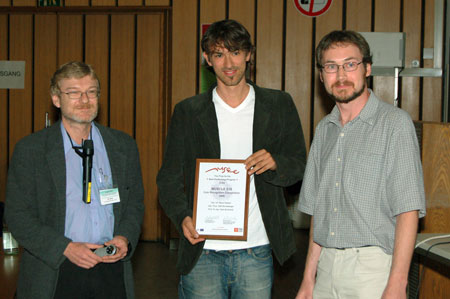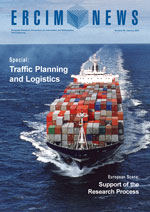by Allan Hanbury and Michael Nölle
A competition to find the best automated coin classification algorithm, with a prize sponsored by the MUSCLE Network of Excellence, was organised in 2006. The results were presented at a workshop held in September 2006 at the Heinrich Hertz Institute in Berlin in conjunction with the 28th Annual Symposium of the German Association for Pattern Recognition (DAGM). The prize of €1500 for the best performing coin classification program went to Marco Reisert, Olaf Ronneberger and Hans Burkhardt of the Chair of Pattern Recognition and Image Processing, University of Freiburg, Germany.
The training and test images for the competition are from the Coin Images Seibersdorf (CIS) database. This database was created as a result of the changeover from twelve European currencies to the Euro, when large volumes of mixed coin collections collected by charitable organisations had to be returned properly sorted to the national banks of the originating countries. During an automatic sorting process carried out at the Austrian Research Centers GmbH - ARC, the CIS database with manually verified classification of coin types was created.
The training data provided to the participants consists of 30000 coins, corresponding to 60000 images (as the front and back of each coin is imaged). These are divided into 692 coin classes with 2270 different coin face classes. There are more coin face classes than coin classes as some coins changed their appearance over time, when new coin series were issued or designs to mark special occasions were introduced.
The task of each participant in the competition was to write a coin classification program and submit it to the organisers. Each program was then run on an unreleased competition dataset consisting of 10000 coins. Coins belonging to 362 of the 692 coin classes in the training data were present in the competition dataset, as well as 242 coins not belonging to any of these classes. The latter were to be classified as unknown. To simulate the demand by the national banks that only 1 in 10000 coins be classified incorrectly, an incorrect classification was penalised more heavily than a classification into the class of unknown coins.

Of the seven initial registrations for the competition, three programs were submitted. Two of these ran correctly on the competition data. The prize went to Marco Reisert, Olaf Ronneberger and Hans Burkhardt, University of Freiburg, Germany. Their program classified 9724 of the 10000 coins correctly and no coins incorrectly (all others were classified as unknown). The algorithm used is based on the analysis of the direction of gradient vectors.
More details on the competition, the algorithms submitted and the results can be found on the coin competition webpage. It is also possible to download the training set. The competition dataset, along with coin classifications, will be available here soon.
A second MUSCLE CIS Coin Competition is planned to take place in 2007. The details can be found on the coin competition webpage.
MUSCLE (Multimedia Understanding through Semantics, Computation and Learning) is a Network of Excellence managed by ERCIM.
Links:
MUSCLE NoE page: http://www.muscle-noe.org
MUSCLE coin competition page: http://muscle.prip.tuwien.ac.at/coin_prize_2006.php
Chair of Pattern Recognition and Image Processing, University of Freiburg:
http://lmb.informatik.uni-freiburg.de
Seibersdorf Coin Recognition Machine:
http://www.smart-systems.at/products/products_image_processing_coin_en.html
Please contact:
Allan Hanbury
Technical University Vienna, Austria
Tel: +43 1 58801 18359
E-mail: hanbury![]() prip.tuwien.ac.at
prip.tuwien.ac.at
Michael Nölle
Austrian Research Centers GmbH - ARC / AARIT, Austria
E-mail: michael.noelle![]() arcs.ac.at
arcs.ac.at










